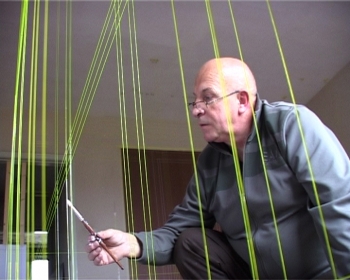ERIK CROUX (BE)
 ( T )Here 2010 - 1951 Bilzen, België leeft en werkt in Hasselt, België 0 1951 Bilzen, Belgium lives and works in Hasselt, Belgium 0 1951 Met de installatie(T)Here roept Eric Croux de herinnering op aan een woon-, slaap- en badkamer in de leegstaande woning van zijn vader, die ondertussen is afgebroken. Deze constructie wordt nu voor Coup de ville hermaakt. Croux begon aan de installatie tewerken toen hij het nieuws van de nakendesloop te horen kreeg en ontwikkelde het concept ervan rond de vraag: “Wat is er nog, (T)Here handelt hierdoor over de spanning tussen elkaar ontkennende, doch op elkaar aangewezen begrippenparen: aan- en afwezig, zichtbaar en onzichtbaar. Eric Croux zelf beschouwt dit kunstwerk als een performance. Toch krijgt men enkelde sporen te zien van de acties die aan hetwerk voorafgingen: het oproepen van deherinneringen, de prospectie van de ruimte,de geestelijke opbouw van het werk en het afbakenen van de vormen. Zoals Croux zelf aangeeft, is het kunstwerk daarmee verschillende stadia gepasseerd, die haartegelijk belemmeren en vormgeven.Toch werken wij als publiek, door ons kijken endenken, verder geestelijk mee aan de vorming van het kunstwerk. Wij maken de realiteit; ze is een mentale constructie. Onze herinneringen zijn reconstructies, qua verbeeldingskracht steeds ongelimiteerd, maar nooit volledig. Deze onvolledigheid maakt dat we als mens genoodzaakt zijn elkaars geheugente vervolledigen.
With his installation(T)Here, Eric Croux evokes memories of a living room, bedroom and bathroom in his father’s vacant house,which has since been demolished. This structure is being reassembled forCoupe deville.Croux started work on the installation when he received news of the impending demolition, and developed the concept around the question of “What is still there; what is no longer there?” From there he workedaround a design that reconciles construction, deconstruction and reconstruction, and simplifies space visually through an abstract language of form. The original objects, and the way they are handled, have been transformed in this way into constructive ribs, lines, patches of wear, impressions or barely visible traces. Consequently, (T)Here is about the tensionbetween pairs of concepts that deny butnevertheless depend upon each other: present and absent, visible and invisible. Eric Croux himself regards this work of art asa performance. However, one only gets to seethe traces of the activities that preceded thework: the recall of memories, the examination of space, the intellectual structure of the work,and the delineation of the forms. As Croux himself indicates, the artwork has passed through several stages in this way, which both inhibit it and give it form.Yet, we as the public intellectually contributeto the formation of the artwork, by looking at it and thinking about it. We create reality; it is a mental construction. Our memories are reconstructions, always without limitation interms of imagination, but never complete. This incompleteness means that we as people are compelled to complete each other’s memories. |